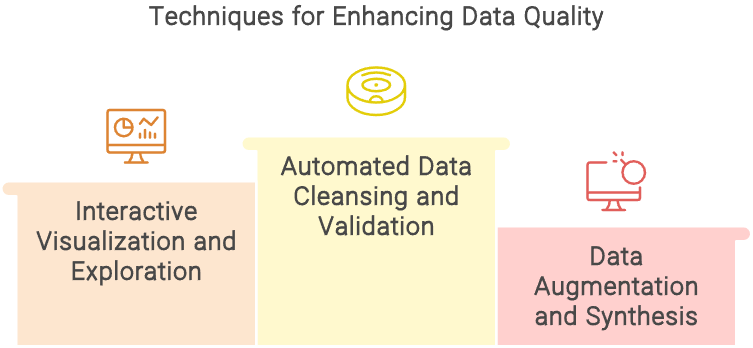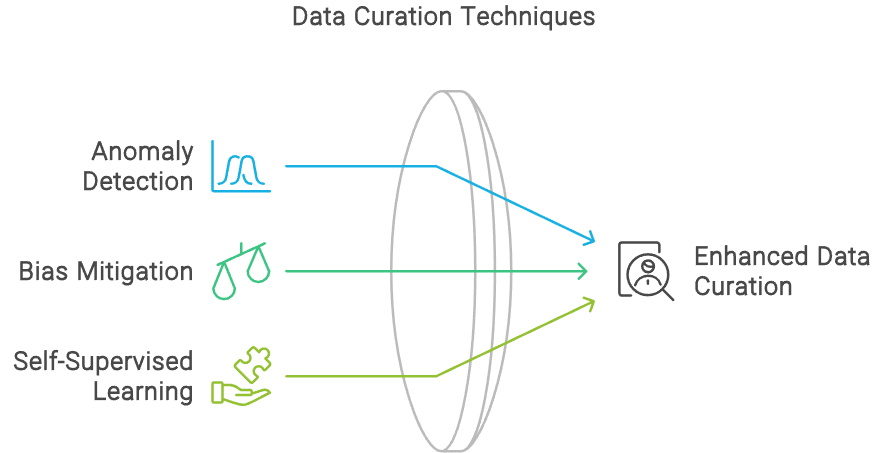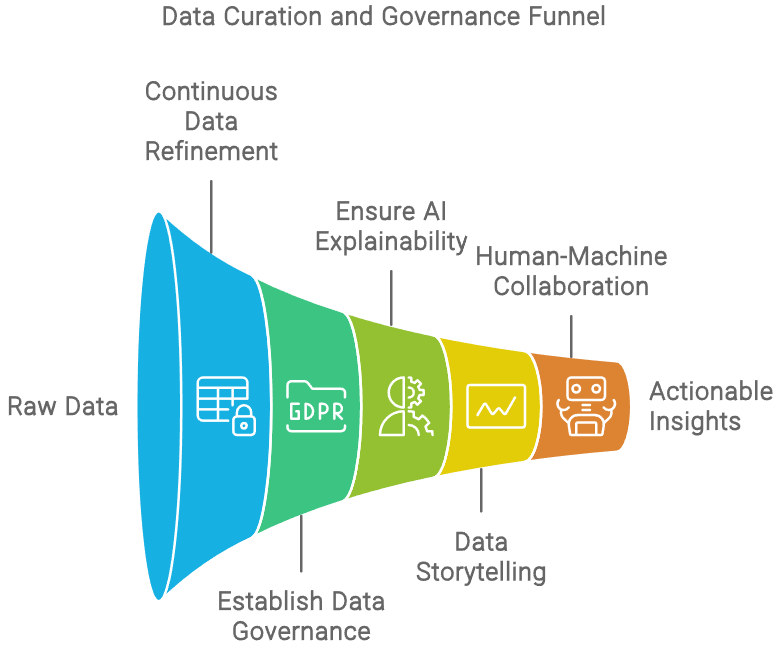Improving the quality of AI training data is not just about gathering and cleaning data. It requires a nuanced approach that goes beyond conventional practices, especially given the complexities and biases inherent in diverse datasets. Drawing on recent research, this article will explore 10 advanced techniques that can significantly enhance the effectiveness of AI training datasets.
These methods, rooted in empirical findings, are designed to elevate the performance of AI models by improving data richness, relevance, and purity. For data curation professionals, understanding and implementing these techniques is crucial for ensuring that AI models perform accurately and fairly.

1. Data Augmentation and Synthesis
Data augmentation is a powerful technique for increasing the diversity of your dataset without the need to collect new data. By applying transformations such as cropping, rotating, and adjusting the brightness of images, you can generate new training examples from existing ones. This method not only expands the dataset but also helps the AI model become more robust to variations in data.
For instance, a data curator working in healthcare might use data augmentation to improve a model designed for diagnosing skin conditions. By augmenting images of skin lesions with various transformations, the curator can create a more diverse training set that allows the model to better recognize conditions under different lighting or angles. This process enhances the model’s ability to generalize, leading to more accurate diagnoses across a wider range of scenarios.
2. Interactive Visualization and Exploration
Interactive visualization tools are essential for identifying biases and quality issues within datasets. These tools allow data curators to explore datasets in real time, making it easier to detect and correct inconsistencies or gaps in the data. By visualizing data, curators can uncover patterns or biases that might not be immediately apparent through traditional data review methods.
Imagine a data curator working in finance, tasked with curating transaction data for fraud detection. Using an interactive visualization tool, they might notice that certain types of transactions are underrepresented in the dataset. By identifying this gap, the curator can take steps to acquire additional data or adjust the model to account for this bias, ultimately improving the accuracy of the fraud detection system.

3. Automated Data Cleansing and Validation
AI-driven tools can automate the tedious task of data cleansing, ensuring that the dataset is free of errors such as typos, duplicates, and missing values. These tools can also standardize data formats and learn from feedback to continuously improve their accuracy. Automating these processes allows data curators to maintain high data quality without the extensive manual effort traditionally required.
For example, a data curator in the retail industry might use an AI tool to cleanse customer data. This tool could automatically correct common errors in customer addresses, merge duplicate entries, and fill in missing information where possible. By automating these tasks, the curator can focus on more strategic aspects of data curation, such as ensuring the data’s relevance to current marketing campaigns.
4. Machine Learning for Anomaly Detection
Machine learning models can be trained to identify anomalies and outliers in datasets, which are critical to maintaining the integrity of the data. Detecting these anomalies early prevents them from skewing the model's performance and ensures that the data used for training is clean and reliable. Anomaly detection is particularly useful in fields where data is collected from numerous sources, such as IoT or sensor networks.
Consider a data curator working with environmental data collected from various sensors. By applying a machine learning model trained to detect anomalies, the curator can quickly identify sensor malfunctions or data points that fall outside of expected ranges. This allows them to correct or remove faulty data before it impacts the training of predictive models used for weather forecasting or environmental monitoring.
5. Bias Mitigation in Data Curation
Bias in AI systems often stems from biased training data, which can lead to unfair or inaccurate outcomes. Addressing this requires proactive data curation strategies, such as data documentation, human-in-the-loop workflows, and the use of bias detectors. By actively curating datasets to minimize bias, data curators can help ensure that AI models are fair and accurate.
For example, a data curator working on a hiring algorithm might notice that the training data includes a disproportionate number of male candidates, which could introduce gender bias. By documenting this bias and using bias detection tools, the curator can take steps to correct the imbalance, such as sourcing additional data that includes more female candidates or adjusting the algorithm to account for this bias. This proactive approach helps create a more equitable AI system.
Practical Example
Let’s explore how an entry-level data curator can utilize these advanced techniques to effectively curate and enhance web-scraped data. Imagine you’re tasked with cleaning and preparing a dataset scraped from various e-commerce websites. The dataset includes product descriptions, prices, user reviews, and images.
Given the diverse and unstructured nature of web-scraped data, applying these curation techniques is essential to ensure the dataset is usable for training an AI model that recommends products to customers. You begin by using data augmentation to improve the images by applying transformations such as cropping and brightness adjustments. This creates a more standardized and diverse set of images for the AI model to learn from.
Next, you explore the dataset using an interactive visualization tool like Tableau, which helps you identify inconsistencies such as missing price data or unusual price ranges. To clean the data, you deploy an AI-driven data cleansing tool that corrects common errors and standardizes formats across the dataset. Finally, you apply a machine learning model to detect anomalies, ensuring the dataset is clean and reliable before using it to train the AI model.
6. Self-Supervised Learning
Self-supervised learning is a technique that allows AI models to learn from unlabeled data by creating proxy tasks. For instance, a model might be trained to predict the next word in a sentence or to colorize a grayscale image, using the context provided by the rest of the data. This approach reduces the reliance on large amounts of manually labeled data, making it particularly valuable for data curators who need to enhance datasets without extensive annotation.

Imagine a data curator working on a text classification model for customer reviews. Instead of manually labeling thousands of reviews, they could use self-supervised learning to train the model to predict missing words in sentences. This technique helps the model develop a deeper understanding of language patterns, which can then be transferred to more complex tasks like sentiment analysis.
7. Continuous Data Curation
Continuous data curation involves the ongoing refinement and updating of datasets to ensure they remain relevant and accurate over time. This technique is crucial in industries where data is constantly evolving, such as finance or e-commerce. By regularly curating the data, curators can correct errors, incorporate new information, and remove outdated entries, thereby maintaining the integrity and usefulness of the dataset.
For example, a data curator working for an e-commerce platform might regularly update the product catalog by adding new items, removing discontinued products, and correcting any discrepancies. This continuous curation process ensures that the AI model powering the recommendation engine always has the most current and accurate data to work with, leading to better customer experiences and more relevant product suggestions.
8. Data Governance and AI Explainability
Data governance is about establishing clear policies and procedures for managing data throughout its lifecycle. In the context of AI, this includes ensuring that data is collected, stored, and used in ways that are ethical, transparent, and compliant with regulations. AI explainability, a key component of data governance, involves making the decision-making processes of AI models understandable to stakeholders, which is critical for building trust in AI systems.
Consider a data curator working in healthcare, where patient data must be handled with the utmost care. Implementing robust data governance practices ensures that all patient data is used ethically and in compliance with laws like HIPAA. Additionally, by focusing on AI explainability, the curator can help healthcare professionals understand how AI models make diagnostic recommendations, increasing their confidence in these tools.
9. Data Storytelling and Visualization
Data storytelling combines data visualization with narrative techniques to communicate insights effectively. It’s not just about presenting data but about telling a story that helps stakeholders understand the significance of the findings and how they can be applied. For data curators, this means transforming complex data into clear, actionable insights that decision-makers can easily grasp.
A data curator working in marketing, for example, might use data storytelling to explain how customer behavior has shifted over time. By visualizing trends and patterns and narrating the implications for future campaigns, the curator helps the marketing team make informed decisions. This approach makes the data more accessible and increases its impact on strategic planning.

10. Collaboration Between Humans and Machines
Effective data curation often involves a collaboration between human intuition and machine efficiency. Machines excel at processing large amounts of data quickly, automating repetitive tasks, and detecting patterns that might be missed by humans. However, human curators bring context, creativity, and critical thinking to the table, ensuring that the data is not only clean but also meaningful and relevant.
For instance, a data curator in a media company might use machine learning to automatically categorize vast amounts of content, such as articles or videos. While the machine handles the bulk of the work, the curator reviews the results to ensure that the categories align with the company’s editorial standards and audience needs. This collaboration ensures that the curated data supports the company’s goals and resonates with its audience.
How to Master Data Curation Techniques without a Formal Degree
The field of data curation is rapidly evolving, and the good news is that you don't need a formal degree to excel in it. With the right resources and dedication, anyone can learn how to curate data effectively and apply advanced techniques. AI tools and online learning platforms have made it easier than ever to acquire these skills, enabling you to become proficient and efficient in data curation.
Leveraging AI-Powered Learning Platforms
AI-powered learning platforms like Coursera, edX, and Udacity offer specialized courses that teach data curation techniques. These platforms often include hands-on projects where you can apply what you've learned in a practical setting. For example, you can take a course on data science that includes modules on data cleaning, augmentation, and visualization, all of which are essential skills for data curators.
Moreover, these platforms use AI to personalize your learning experience, suggesting courses and materials based on your progress and interests. This tailored approach helps you focus on areas where you need the most improvement, making your learning journey more efficient and effective.
Using AI Tools for Self-Education
AI tools like GPT-based language models, data visualization software, and automated data cleansing tools can serve as both learning aids and practical resources. For instance, you can use AI-driven language models to generate explanations, tutorials, and even code snippets to help you understand complex data curation concepts. Tools like Kaggle also offer community-driven tutorials and datasets that you can use to practice and hone your skills.
If you're learning how to clean data, platforms like Trifacta offer free versions where you can practice using their AI-powered data wrangling tools. These tools guide you through the process of cleaning and transforming data, helping you learn by doing. By experimenting with these tools, you can develop a practical understanding of advanced data curation techniques.
Engaging with Online Communities and Open Source Projects
Another effective way to learn data curation is by engaging with online communities such as Reddit, Stack Overflow, and Data Science forums. These communities are rich with discussions, tutorials, and problem-solving threads that can help you learn from others' experiences. Participating in open-source projects on platforms like GitHub can also provide hands-on experience, allowing you to contribute to real-world data curation tasks while learning from more experienced contributors.
By collaborating with others and asking questions, you can accelerate your learning and gain insights that aren't always covered in traditional courses. Open-source projects often include documentation and community support, making it easier for beginners to get started and understand complex processes.
Practical Application through AI Competitions
Platforms like Kaggle host data science competitions where you can apply what you've learned in a competitive, real-world environment. These competitions often involve curating and analyzing datasets to solve specific problems, giving you a chance to practice advanced techniques such as anomaly detection, bias mitigation, and data augmentation.
Participating in these competitions not only enhances your skills but also builds your portfolio, which can be valuable when seeking employment in data-related fields. The feedback and ranking you receive from these competitions provide insights into your strengths and areas for improvement, helping you refine your skills further.
Continuous Learning with AI Recommendations
AI doesn't just help you learn; it can also keep you updated on the latest developments in data curation. By following AI-curated content feeds on platforms like Medium, LinkedIn, and specialized data science blogs, you can stay informed about new tools, techniques, and best practices. AI can recommend articles, tutorials, and webinars based on your learning history, ensuring that you're always aware of the latest trends and innovations in data curation.

Leveraging AI-Powered Learning Platforms
AI-powered learning platforms like Coursera, edX, and Udacity offer specialized courses that teach data curation techniques. These platforms often include hands-on projects where you can apply what you've learned in a practical setting. For example, you can take a course on data science that includes modules on data cleaning, augmentation, and visualization, all of which are essential skills for data curators.
Moreover, these platforms use AI to personalize your learning experience, suggesting courses and materials based on your progress and interests. This tailored approach helps you focus on areas where you need the most improvement, making your learning journey more efficient and effective.
Using AI Tools for Self-Education
AI tools like GPT-based language models, data visualization software, and automated data cleansing tools can serve as both learning aids and practical resources. For instance, you can use AI-driven language models to generate explanations, tutorials, and even code snippets to help you understand complex data curation concepts. Tools like Kaggle also offer community-driven tutorials and datasets that you can use to practice and hone your skills.
If you're learning how to clean data, platforms like Trifacta offer free versions where you can practice using their AI-powered data wrangling tools. These tools guide you through the process of cleaning and transforming data, helping you learn by doing. By experimenting with these tools, you can develop a practical understanding of advanced data curation techniques.
Engaging with Online Communities and Open Source Projects
Another effective way to learn data curation is by engaging with online communities such as Reddit, Stack Overflow, and Data Science forums. These communities are rich with discussions, tutorials, and problem-solving threads that can help you learn from others' experiences. Participating in open-source projects on platforms like GitHub can also provide hands-on experience, allowing you to contribute to real-world data curation tasks while learning from more experienced contributors.
By collaborating with others and asking questions, you can accelerate your learning and gain insights that aren't always covered in traditional courses. Open-source projects often include documentation and community support, making it easier for beginners to get started and understand complex processes.
Practical Application through AI Competitions
Platforms like Kaggle host data science competitions where you can apply what you've learned in a competitive, real-world environment. These competitions often involve curating and analyzing datasets to solve specific problems, giving you a chance to practice advanced techniques such as anomaly detection, bias mitigation, and data augmentation.
Participating in these competitions not only enhances your skills but also builds your portfolio, which can be valuable when seeking employment in data-related fields. The feedback and ranking you receive from these competitions provide insights into your strengths and areas for improvement, helping you refine your skills further.
Continuous Learning with AI Recommendations
AI doesn't just help you learn; it can also keep you updated on the latest developments in data curation. By following AI-curated content feeds on platforms like Medium, LinkedIn, and specialized data science blogs, you can stay informed about new tools, techniques, and best practices. AI can recommend articles, tutorials, and webinars based on your learning history, ensuring that you're always aware of the latest trends and innovations in data curation.
Conclusion
The quality of AI training data is paramount to the success of any AI system. By adopting advanced techniques like data augmentation, interactive visualization, automated cleansing, and continuous curation, organizations can significantly improve the performance and fairness of their AI models. These strategies not only enhance data quality but also ensure that AI systems remain relevant and reliable over time.
References:
- Cleanlab. (n.d.). The Critical Role of Data Curation in AI and Analytics. Retrieved from Cleanlab Blog
- LinkedIn. (2023, March 16). How AI Improves Data Quality and Consistency. Retrieved from LinkedIn Advice
- Treasure Data. (2023, June 13). Using AI/ML to Improve Data Quality. Retrieved from Treasure Data Blog
- Alation. (2022, June 30). New Age of Data Curation: Challenges & Best Practices. Retrieved from Alation Blog
- Atlan. (2023, October 17). Data Curation in Machine Learning: Ultimate Guide 2024. Retrieved from Atlan Blog






